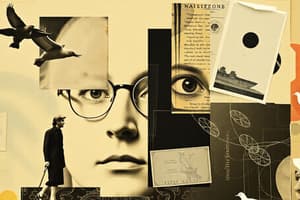Podcast
Questions and Answers
What are Monocular Cues?
What are Monocular Cues?
Available to each eye separately
What does Relative Size refer to?
What does Relative Size refer to?
If we assume that two objects are similar in size, we perceive the one that casts the smaller retinal image as farther away.
What is Interposition?
What is Interposition?
If one object partially blocks our view of another, we perceive it as closer.
What does Relative Clarity indicate?
What does Relative Clarity indicate?
What is Texture Gradient?
What is Texture Gradient?
What does Relative Height suggest?
What does Relative Height suggest?
What is Relative Motion (Motion Parallax)?
What is Relative Motion (Motion Parallax)?
What does Linear Perspective refer to?
What does Linear Perspective refer to?
What role does Light and Shadow play in perception?
What role does Light and Shadow play in perception?
Flashcards are hidden until you start studying
Study Notes
Monocular Cues
- Perception methods available to individual eyes, allowing depth perception without binocular assistance.
Relative Size
- When two similarly sized objects are compared, the smaller retinal image is perceived as being farther away.
Interposition
- Objects that obstruct our view of others are perceived as nearer, indicating spatial relationships in depth.
Relative Clarity
- Distant objects appear hazy due to atmospheric interference, leading to the perception that clearer objects are closer.
Texture Gradient
- A shift from coarse to fine texture suggests increasing distance; textures become less distinct as distance increases.
Relative Height
- Objects positioned higher in the visual field are perceived as farther away; lower parts are viewed as closer, impacting figure-ground perception.
Relative Motion (Motion Parallax)
- As an observer moves, closer objects seem to move in the opposite direction while distant objects appear to move in the same direction. The speed of apparent movement increases with proximity.
Linear Perspective
- Parallel lines converge with distance; the degree of convergence indicates how far away an object or path is perceived.
Light and Shadow
- Objects closer to the light source appear brighter; in comparisons of similar objects, the one that is dimmer is interpreted as being farther away.
Studying That Suits You
Use AI to generate personalized quizzes and flashcards to suit your learning preferences.





